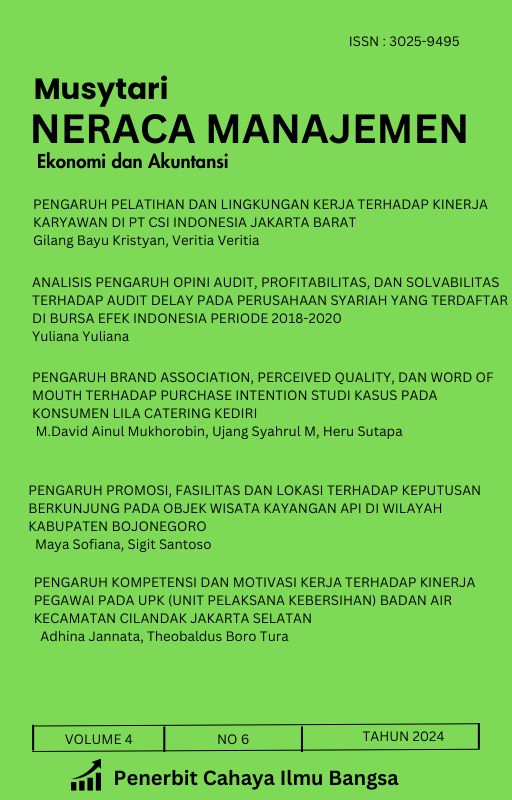Articles
Published 2025-06-09
Keywords
- Corporate culture; Burnout; Company; Employees
How to Cite
PERAN BUDAYA PERUSAHAAN DALAM MENCEGAH BURNOUT PADA KARYAWAN. (2025). Musytari : Jurnal Manajemen, Akuntansi, Dan Ekonomi, 18(7), 11-20. https://doi.org/10.2324/10fay003
Abstract
This study aims to find out how important the role of corporate culture is in preventing burnout in its employees. The research method used is library research as the main approach in collecting data and information. This method was chosen because the study focuses on collecting, studying, and analyzing various available reference sources, such as books, scientific journals, articles, reports, and other documents that are relevant to the research topic. This study shows that culture in a company also affects employee mental health.
References
- Martins, E. C., & Terblanche, F. (2003). Building organisational culture that stimulates creativity and innovation. European Journal of Innovation Management
- Hofstede, G. (2001). Culture’s Consequences: Comparing Values, Behaviors, Institutions, and Organizations Across Nations. Sage Publications.
- Kotter, J. P., & Heskett, J. L. (1992). Corporate Culture and Performance.
- Maslach, C., & Leiter, M. P. (2016). Understanding the burnout experience: Recent research and its implications for psychiatry. World Psychiatry, 15(2), 103–111.
- Hobfoll, S. E. (2001). The influence of culture, community, and the nested-self in the stress process: Advancing conservation of resources theory. Applied Psychology, 50(3), 337-421.
- https://jurnal.yudharta.ac.id/v2/index.php/malia/article/view/3793
- https://jurnal.untag-sby.ac.id/index.php/jiwa/article/view/11504
- https://jurnal.risetilmiah.ac.id/index.php/JAM/article/view/99?utm_source.
- https://wnj.westscience-press.com/index.php/jpkws/article/view/1536?utm_source=
- https://ejournal.warunayama.org/index.php/liberosis/article/view/10579?utm_source=
- https://www.researchgate.net/publication/277887037_Internal_Crisis_Communication_Strategies_to_Protect_Trust_Relationships_A_Study_of_Italian_Companies
- https://journal.seisense.com/index.php/jom/article/view/121
- https://psycnet.apa.org/record/2001-06598-003
- https://www.sciencedirect.com/science/article/abs/pii/S0001879104000165
- https://www.nber.org/papers/w25380
- Maslach, C., & Leiter, M. P. (2016). Burnout. In G. Fink (Ed.), Stress: Concepts, cognition, emotion, and behavior (pp. 351-357). Elsevier.
- Schaufeli, W. B., & Bakker, A. B. (2004). Job demands, job resources, and their relationship with burnout and engagement: A multi-sample study. Journal of Organizational Behavior, 25(3), 293-315. https://doi.org/10.1002/job.248
- Halbesleben, J. R., & Buckley, M. R. (2004). Burnout in organizational life. Journal of Management, 30(6), 859-879. https://doi.org/10.1016/j.jm.2004.06.004
- Golembiewski, R. T., Munzenrider, R. F., & Stevenson, J. G. (1986). Stress in organizations: Toward a phase model of burnout. Journal of Applied Behavioral Science, 22(4), 504-525. https://doi.org/10.1177/002188638602200408
- Beauregard, T. A., & Henry, L. C. (2009). Making the link between work-life balance practices and organizational performance. Human Resource Management Review, 19(1), 9-22. https://doi.org/10.1016/j.hrmr.2008.09.001
- Avey, J. B., Luthans, F., & Jensen, S. M. (2009). Psychological capital: A positive resource for combating employee stress and turnover. Human Resource Management, 48(5), 677-693. https://doi.org/10.1002/hrm.20294
- Kelloway, E. K., Turner, N., Barling, J., & Loughlin, C. (2012). Transformational leadership and employee psychological well-being: The mediating role of employee trust in leadership. Work & Stress, 26(1), 39-55. https://doi.org/10.1080/02678373.2012.66077
- Spector, P. E. (1997). Job satisfaction: Application, assessment, cause, and consequences. SAGE Publications.
- Armenakis, A. A., & Bedeian, A. G. (1999). Organizational change: A review of theory and research in the 1990s. Journal of Management, 25(3), 293-315. https://doi.org/10.1016/S0149-2063(99)00004-5
- Ivancevich, J. M., Konopaske, R., & Matteson, M. T. (2014). Organizational behavior and management (10th ed.). McGraw-Hill Education.
- Luthans, F. (2002). Positive organizational behavior: Developing and managing psychological strengths. Academy of Management Executive, 16(1), 57-72. https://doi.org/10.5465/ame.2002.6640181
- Kossek, E. E., & Ozeki, C. (1998). Work-family conflict, policies, and the job-life satisfaction relationship: A review and directions for organizational behavior-human resources research. Journal of Applied Psychology, 83(2), 139-149. https://doi.org/10.1037/0021-9010.83.2.139

